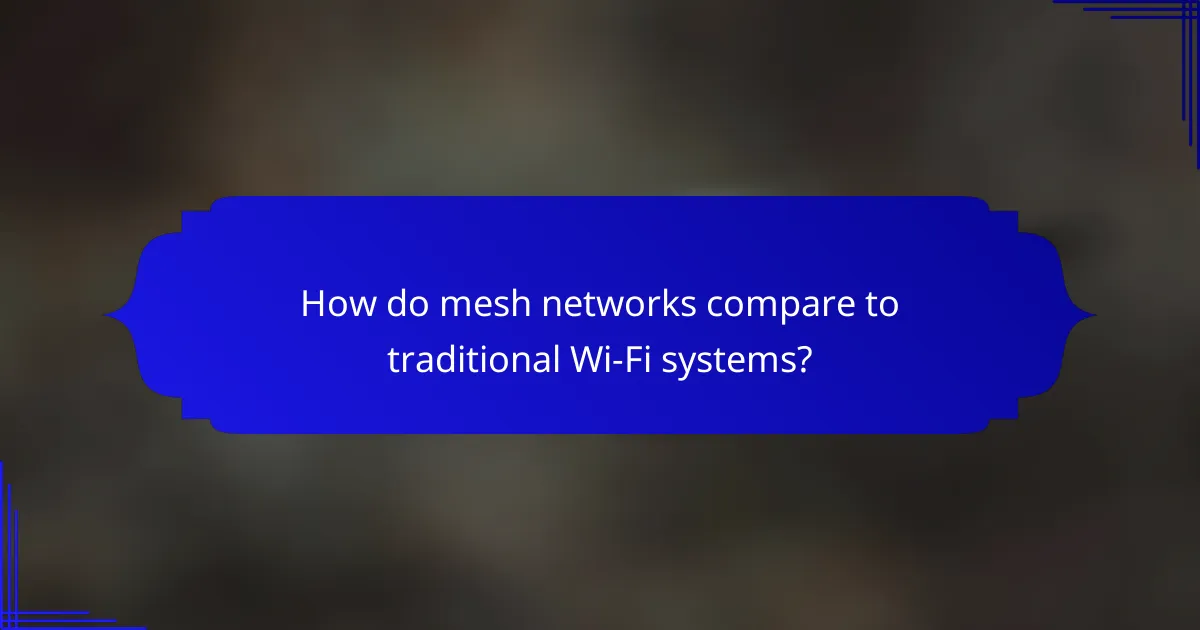Mesh networks are an innovative solution for enhancing coverage and reliability by connecting multiple nodes that communicate seamlessly with one another. This interconnected design not only extends network reach into challenging areas but also provides redundancy, ensuring continuous service even during disruptions. Additionally, mesh networks feature self-healing capabilities, automatically rerouting data when nodes fail, thereby maintaining connectivity and minimizing service interruptions.

How do mesh networks provide coverage in New Zealand?
Mesh networks enhance coverage in New Zealand by utilizing multiple interconnected nodes that communicate with each other, ensuring a robust and extensive network. This design allows for greater flexibility in reaching areas that traditional networks may struggle to cover.
Wide area coverage
Mesh networks can effectively cover large areas by deploying numerous nodes that work together to extend the signal range. In rural New Zealand, where distances between homes can be significant, this approach allows for consistent connectivity without the need for extensive cabling or infrastructure.
By strategically placing nodes throughout a region, users can achieve seamless internet access across various terrains, making mesh networks ideal for both urban and remote locations.
Elimination of dead zones
One of the key advantages of mesh networks is their ability to eliminate dead zones, which are areas with weak or no signal. Each node in a mesh network can relay data, ensuring that even the most isolated spots receive coverage.
For instance, in a large house or a multi-story building, strategically positioning nodes can significantly reduce or eliminate areas where connectivity is typically poor, providing a more reliable internet experience.
Optimal placement strategies
To maximize coverage and performance in a mesh network, optimal placement of nodes is crucial. Nodes should be positioned within a reasonable distance of each other, typically around 30 to 50 meters, to maintain strong communication links.
Consider factors such as physical obstructions, like walls or trees, and the layout of the area when determining node placement. Utilizing tools or apps that analyze signal strength can help identify the best locations for each node, ensuring comprehensive coverage throughout the desired area.

What redundancy features do mesh networks offer?
Mesh networks provide significant redundancy features that enhance reliability and ensure continuous connectivity. By utilizing multiple nodes, these networks can maintain service even if some connections fail, making them resilient to disruptions.
Multiple nodes for reliability
Mesh networks consist of numerous interconnected nodes, which work together to create a robust communication system. Each node can relay data, so if one node goes offline, others can take over its responsibilities, ensuring that the network remains operational. This redundancy minimizes the risk of total network failure.
For example, in a home mesh network, if one access point loses power, devices can automatically connect to another nearby access point without user intervention. This seamless transition enhances user experience and maintains connectivity.
Automatic rerouting of traffic
One of the key features of mesh networks is their ability to automatically reroute traffic when a node becomes unavailable. This self-healing capability allows the network to adapt in real-time, finding alternative paths for data transmission. As a result, users experience minimal disruption during outages.
For instance, if a node fails in a large office building, the network can quickly redirect data through other nodes, maintaining high-speed access for all devices. This dynamic rerouting is crucial for applications that require constant connectivity, such as video conferencing or online gaming.
Comparison with traditional networks
In traditional networks, a single point of failure can lead to significant downtime, as the entire system relies on a central hub or router. In contrast, mesh networks distribute the load across multiple nodes, reducing the impact of any single failure. This decentralized approach enhances reliability and performance.
Moreover, traditional networks often require manual intervention to restore connectivity after a failure, which can take time. Mesh networks, however, automatically adjust and reroute traffic, providing a more efficient and user-friendly experience. This makes mesh networks particularly suitable for environments where consistent connectivity is essential.

How do mesh networks achieve self-healing capabilities?
Mesh networks achieve self-healing by automatically detecting node failures and rerouting data through alternative paths. This ensures continuous connectivity and minimizes disruptions in service, making them highly resilient to individual node issues.
Node failure detection
Node failure detection in mesh networks involves monitoring the status of each node and identifying when a node becomes unresponsive. This can be accomplished through heartbeat signals or periodic status checks, which help maintain an accurate view of the network’s health.
When a node fails, the network can quickly recognize the issue, often within seconds, allowing for prompt action to mitigate any impact on data transmission. This proactive approach is essential for maintaining reliable communication.
Dynamic reconfiguration
Dynamic reconfiguration allows mesh networks to adapt to changes in topology, such as the failure of a node. When a node is detected as down, the network automatically recalibrates the data routes, finding alternative paths to ensure that data continues to flow smoothly.
This process is typically seamless to users, as the network can reroute traffic in real-time, often without noticeable delays. The flexibility of dynamic reconfiguration is a key strength of mesh networks, enhancing their robustness.
Real-time performance monitoring
Real-time performance monitoring in mesh networks involves continuously assessing the performance metrics of nodes and connections. Metrics such as latency, bandwidth, and packet loss are tracked to ensure optimal operation and to quickly identify any emerging issues.
By utilizing monitoring tools and analytics, network administrators can gain insights into the health of the network and make informed decisions about maintenance or upgrades. This ongoing vigilance is crucial for sustaining the self-healing capabilities of mesh networks.

What are the key benefits of using mesh networks?
Mesh networks offer significant advantages, including improved coverage, redundancy, and self-healing capabilities. These features make them ideal for both residential and commercial applications, ensuring reliable connectivity even in challenging environments.
Scalability for growing networks
Mesh networks are inherently scalable, allowing users to easily expand their network by adding more nodes without major reconfiguration. This flexibility is crucial for businesses and homes that may require additional coverage as they grow.
For instance, a small office can start with a few nodes and gradually add more as the workforce increases, ensuring consistent performance throughout the space. This adaptability helps maintain strong connections across larger areas, making mesh networks suitable for various settings.
Cost-effectiveness in deployment
Deploying a mesh network can be more cost-effective compared to traditional wired networks. Since mesh systems often require less cabling and infrastructure, initial installation costs can be lower, especially in large or complex environments.
Additionally, many mesh devices are designed for easy setup and configuration, reducing labor costs associated with installation. This makes mesh networks an attractive option for budget-conscious users looking to enhance their connectivity.
Enhanced user experience
Mesh networks significantly improve user experience by providing seamless connectivity and reducing dead zones. Users can move freely within the coverage area without experiencing drops in connection quality, which is essential for activities like video streaming and online gaming.
Moreover, the self-healing nature of mesh networks ensures that if one node fails, the system automatically reroutes traffic through other nodes. This redundancy minimizes disruptions and maintains a stable connection, enhancing overall satisfaction for users.

What factors should be considered when choosing a mesh network?
When selecting a mesh network, consider node density and placement, device compatibility, and budget constraints. These factors significantly influence the network’s performance, coverage, and reliability.
Node density and placement
Node density refers to the number of devices in a given area, which directly affects coverage and redundancy. A higher density of nodes typically results in better signal strength and more reliable connections, especially in larger spaces or areas with obstacles.
Proper placement of nodes is crucial for optimal performance. Position nodes in central locations to minimize distance between them and avoid physical barriers like walls or furniture that can weaken signals. A common guideline is to place nodes within a range of 30 to 50 feet of each other, depending on the environment.
Device compatibility
Ensure that all devices in your mesh network are compatible with the chosen system. Different manufacturers may use various protocols, which can lead to connectivity issues. Look for devices that support common standards like Wi-Fi 5 or Wi-Fi 6 for better integration and performance.
Additionally, consider the types of devices you will connect. Some mesh networks may have limitations on the number of devices or specific requirements for smart home devices. Always check the specifications to avoid compatibility problems.
Budget constraints
Your budget will significantly influence the mesh network you choose. Mesh systems can range from affordable options under $100 to high-end solutions exceeding $500. Determine your budget early to narrow down your choices effectively.
Keep in mind that while cheaper options may save money upfront, they might lack features like advanced security or extensive coverage. Investing in a reliable system can reduce long-term costs associated with connectivity issues and device replacements.

How do mesh networks compare to traditional Wi-Fi systems?
Mesh networks provide more extensive coverage and redundancy compared to traditional Wi-Fi systems. While traditional setups rely on a single router, mesh networks use multiple nodes that work together to create a seamless wireless environment.
Performance in large spaces
In large areas, mesh networks excel by distributing signals across multiple nodes, minimizing dead zones. For instance, a mesh network can effectively cover homes or offices exceeding 2,000 square feet, where a single router might struggle.
These systems automatically adjust to network traffic, ensuring consistent performance even with multiple devices connected. This adaptability makes them ideal for environments like warehouses or large homes with thick walls that hinder signal strength.
Setup complexity
Setting up a mesh network is generally straightforward, often requiring just a mobile app for configuration. Users typically place nodes in strategic locations, and the app guides them through the process, making it accessible even for those with limited technical skills.
In contrast, traditional Wi-Fi systems may require more complex configurations, especially when dealing with range extenders or multiple access points. This complexity can lead to potential issues with network stability and performance.
Long-term maintenance costs
Mesh networks can lead to lower long-term maintenance costs due to their self-healing capabilities. If one node fails, the remaining nodes automatically reroute traffic, reducing the need for immediate repairs or replacements.
However, initial investments in mesh systems can be higher than traditional routers. Users should weigh the upfront costs against potential savings in maintenance and improved performance over time, especially in environments with high connectivity demands.
